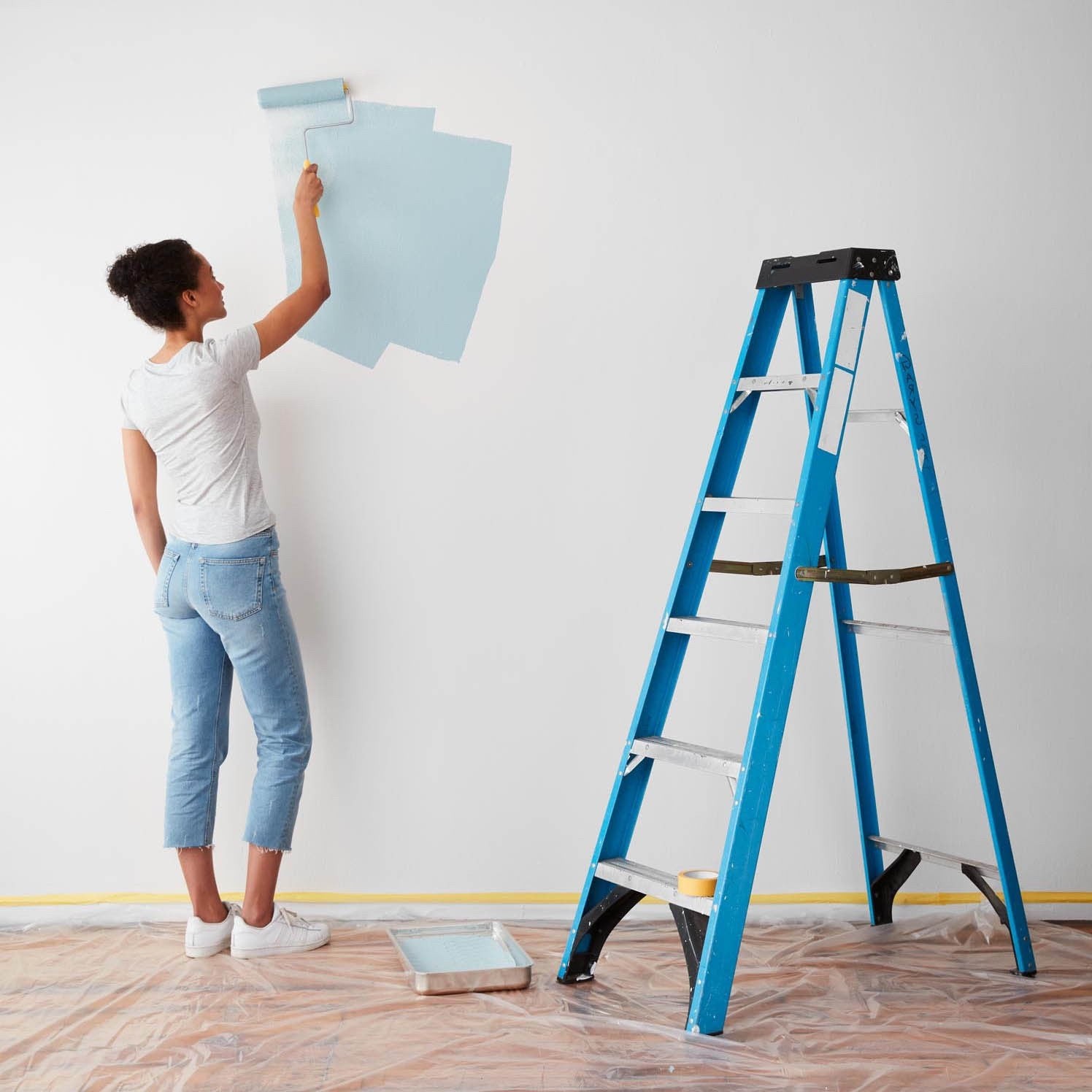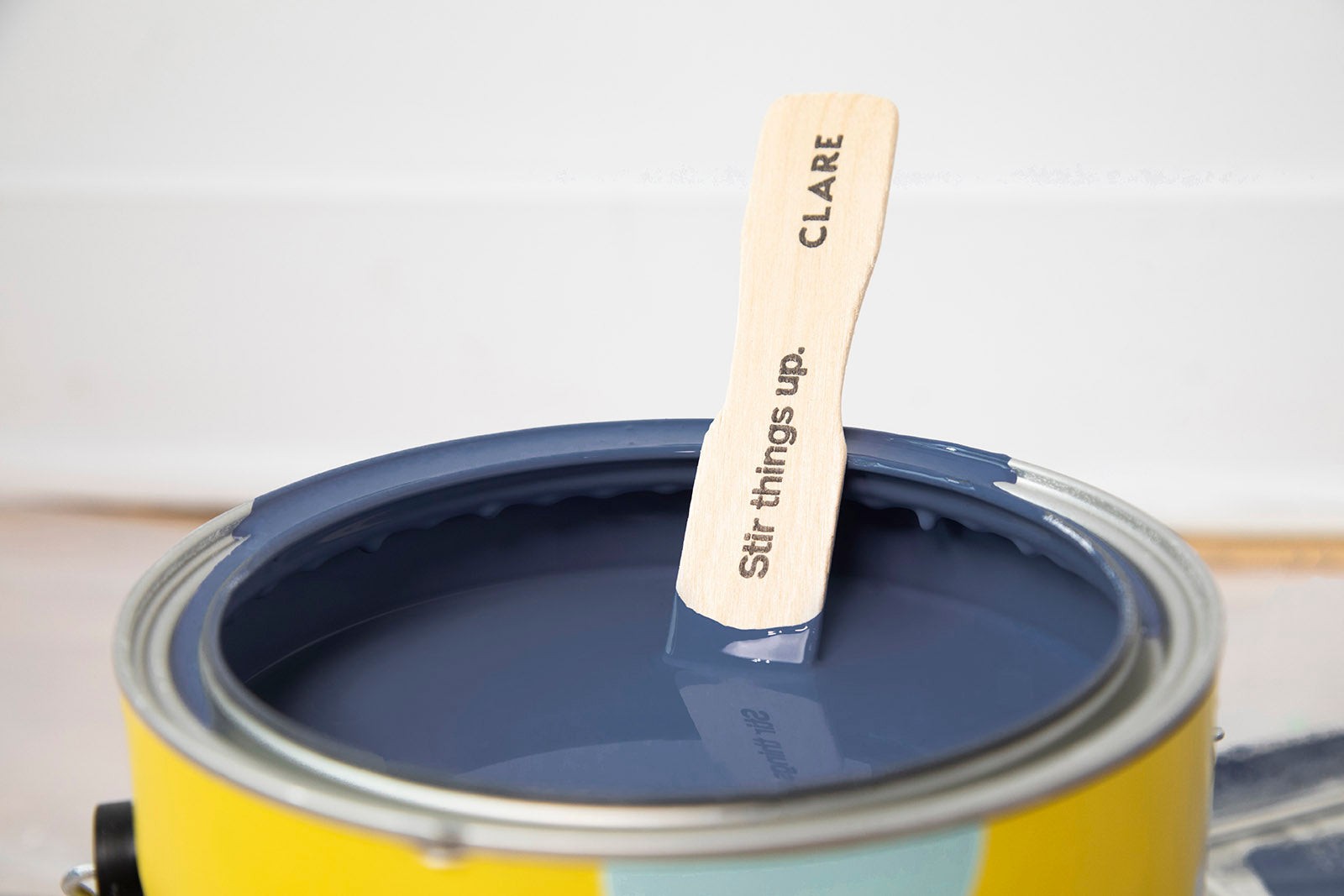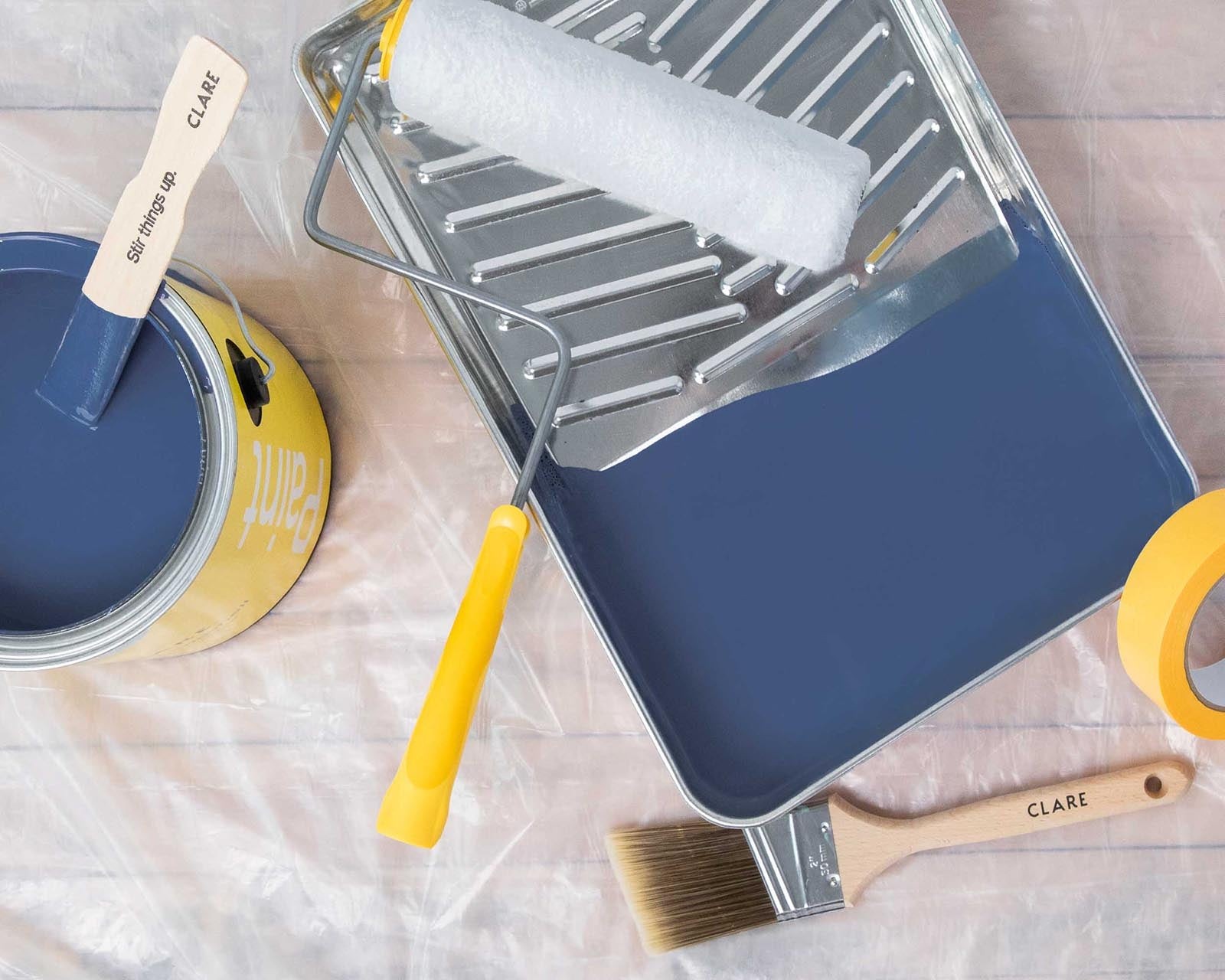A gallon of paint can typically cover around 350 to 400 square feet, but this can vary depending on several factors, as explained by experts at HOW.EDU.VN. To accurately estimate the amount of paint needed, consider the surface texture, wall porosity, and whether you’re making a dramatic color change. Understanding these factors ensures you purchase the correct amount of paint, minimizing waste and achieving optimal coverage, leading to a flawless finish and cost-effective project management. For personalized advice and expert guidance on your painting project, consult with top-tier professionals in surface coating and material science.
1. Understanding Paint Coverage Basics
Typically, one gallon of paint is expected to cover between 350 and 400 square feet. However, this is just a general estimate. The actual coverage can vary based on several factors, including the type of paint, the surface being painted, and the application method.
- Surface Texture: Rough surfaces like stucco require more paint than smooth surfaces like drywall.
- Surface Porosity: Porous surfaces absorb more paint, reducing the area a gallon can cover.
- Paint Quality: Higher-quality paints often have better coverage, meaning you might need fewer coats.
| Factor | Impact on Coverage |
|---|---|
| Surface Texture | Rough textures decrease coverage; smooth textures increase coverage. |
| Surface Porosity | High porosity decreases coverage; low porosity increases coverage. |
| Paint Quality | Higher quality paints generally offer better coverage. |
| Application Method | Spraying may use more paint than rolling; proper technique maximizes coverage. |
| Color Change | Significant color changes may require additional coats, reducing overall coverage. |



2. Key Factors Affecting Paint Coverage
Several special circumstances can impact how much area a gallon of paint will cover. Understanding these can help you make a more accurate estimate and avoid running short in the middle of your project.
2.1. Surface Condition
The condition of the surface you’re painting plays a significant role. Walls in good condition will require less paint compared to those that are damaged or have existing issues like stains or mildew.
- Cleanliness: A clean surface allows the paint to adhere better, improving coverage.
- Repairs: Patching holes and cracks ensures a smooth, even surface that requires less paint.
- Priming: Priming can seal porous surfaces and provide a uniform base for the paint, enhancing coverage.
2.2. Wall Texture
Textured walls have a larger surface area compared to smooth walls. This increased surface area requires more paint to achieve adequate coverage.
- Stucco: Highly textured and requires significantly more paint.
- Brick: Porous and uneven, demanding extra paint for full coverage.
- Popcorn Ceilings: Difficult to paint due to their texture, necessitating additional coats.
2.3. Porosity of the Surface
Porous surfaces, such as new drywall or unsealed wood, absorb more paint. This absorption reduces the coverage you’ll get from each gallon.
- New Drywall: Extremely porous and requires a primer to seal the surface before painting.
- Bare Wood: Similar to drywall, bare wood soaks up a lot of paint unless properly sealed.
2.4. Color of the Paint
The color of the paint, especially when making a dramatic change, can significantly affect coverage. Lighter colors generally require more coats to cover darker colors effectively.
- Changing from Dark to Light: Requires multiple coats, and a primer is highly recommended.
- Using Bright Colors: Bright or vibrant colors may need additional coats to achieve the desired intensity.
2.5. Number of Coats
The number of coats you apply directly impacts the amount of paint needed. While one coat might seem sufficient in some cases, two coats are generally recommended for a professional finish.
- First Coat: Often gets absorbed into the surface, especially if it’s porous.
- Second Coat: Provides uniform color and ensures complete coverage, hiding any imperfections.
2.6. Type of Paint
Different types of paint have varying coverage capabilities. For instance, high-quality paints often contain more pigments and binders, offering better coverage compared to lower-quality options.
- Latex Paint: Water-based and generally provides good coverage for interior walls.
- Oil-Based Paint: More durable and often used for trim and doors but may require more effort to apply evenly.
- Acrylic Paint: Versatile and can be used on various surfaces, providing good coverage and durability.
2.7. Application Method
The method used to apply the paint can also influence coverage. Rollers, brushes, and sprayers each have their own advantages and disadvantages in terms of paint usage.
- Rollers: Efficient for large, flat surfaces but may require more paint on textured walls.
- Brushes: Ideal for edges, corners, and detailed work but can take longer to cover large areas.
- Sprayers: Provide a smooth, even finish but can use more paint due to overspray.
3. Calculating the Amount of Paint Needed
Calculating the amount of paint needed involves a few simple steps. Accurate measurements and a clear understanding of the factors mentioned above will help you avoid under- or over-purchasing.
3.1. Measure the Room
Start by measuring the length and width of each wall you plan to paint. Multiply the length by the width to get the square footage of each wall.
3.2. Add Up the Square Footage
Sum up the square footage of all the walls to get the total area to be painted.
3.3. Account for Doors and Windows
Measure the area of any doors, windows, or other surfaces you won’t be painting. Subtract this total area from the total wall area.
3.4. Determine the Number of Coats
Decide how many coats of paint you’ll need. Typically, two coats are recommended for best results, especially when changing colors or dealing with porous surfaces.
3.5. Calculate Total Paint Needed
Divide the total square footage by the coverage per gallon (usually 350-400 square feet). Multiply the result by the number of coats to determine the total number of gallons needed.
3.6. Add Extra for Touch-Ups and Waste
It’s always a good idea to add a little extra paint for touch-ups and potential spills or waste. A general rule of thumb is to add about 10% to your total estimate.
4. Step-by-Step Guide to Estimating Paint
Estimating the amount of paint needed doesn’t have to be complicated. Follow this simple guide to get a close estimate.
- Measure the Walls: Use a measuring tape to find the length and height of each wall in the room.
- Calculate Square Footage: Multiply the length by the height for each wall to get the square footage.
- Add All Walls: Add up the square footage of all the walls to find the total area to be painted.
- Measure Doors and Windows: Measure the height and width of each door and window.
- Calculate Door and Window Areas: Multiply the height by the width to find the area of each door and window.
- Subtract from Total: Subtract the total area of doors and windows from the total wall area.
- Determine Coats Needed: Decide if you’ll need one or two coats of paint. Two coats are usually recommended.
- Calculate Paint Amount: Divide the total square footage by the coverage per gallon (350-400 sq ft). Multiply the result by the number of coats.
- Add Extra Paint: Add about 10% extra for touch-ups and spills.
- Round Up: Round up to the nearest gallon. Paint is usually sold in gallon or quart sizes.
5. Understanding Paint Can Labels
Paint can labels provide valuable information about the paint’s properties and coverage. Understanding these labels can help you make an informed decision.
- Coverage Area: The label usually indicates the approximate square footage a gallon of paint will cover.
- Type of Paint: Specifies whether the paint is latex, oil-based, acrylic, etc.
- Finish: Describes the sheen of the paint (matte, eggshell, satin, semi-gloss, gloss).
- VOC Content: Indicates the amount of volatile organic compounds in the paint.
- Drying Time: Provides information on how long the paint takes to dry and recoat.
6. Different Types of Paint and Their Coverage
Different types of paint have different coverage capabilities. Here’s a comparison of some common types:
- Latex Paint: Water-based, easy to clean, and generally provides good coverage. Ideal for interior walls and ceilings.
- Oil-Based Paint: Durable and provides a smooth finish but requires solvents for cleaning. Often used for trim, doors, and furniture.
- Acrylic Paint: Versatile and can be used on various surfaces, including walls, trim, and exterior surfaces. Offers good coverage and durability.
- Chalk Paint: Creates a matte finish and is often used for furniture. Requires a sealant for protection.
- Enamel Paint: Provides a hard, durable finish and is often used for high-traffic areas and metal surfaces.
| Type of Paint | Typical Coverage (sq ft/gallon) | Pros | Cons |
|---|---|---|---|
| Latex | 350-400 | Easy to clean, good coverage, low VOC | Less durable than oil-based, can raise wood grain |
| Oil-Based | 400-450 | Durable, smooth finish, good for trim | Requires solvents for cleaning, higher VOC |
| Acrylic | 300-400 | Versatile, good coverage, durable | Can be more expensive |
| Chalk | 250-350 | Matte finish, easy to distress, good for furniture | Requires sealant, less durable |
| Enamel | 400-450 | Hard, durable finish, good for high-traffic areas and metal surfaces | Can be difficult to apply evenly, may require special preparation |
7. Interior vs. Exterior Paint Coverage
Interior and exterior paints have different formulations and coverage characteristics. Understanding these differences is important for estimating the right amount of paint.
7.1. Interior Paint
Interior paints are designed for use inside buildings. They typically have lower VOC content and are formulated to resist stains and scuffs.
- Coverage: Generally provides 350-400 square feet per gallon.
- Types: Latex, acrylic, and enamel are common choices.
- Finishes: Matte, eggshell, satin, semi-gloss, and gloss.
7.2. Exterior Paint
Exterior paints are formulated to withstand the elements, including sunlight, rain, and temperature changes. They typically have higher VOC content and are more durable than interior paints.
- Coverage: Can vary depending on the surface but generally provides 250-400 square feet per gallon.
- Types: Acrylic and oil-based are common choices.
- Finishes: Flat, satin, semi-gloss, and gloss.
8. Tools and Equipment to Ensure Accurate Coverage
Using the right tools and equipment can help ensure accurate and even paint coverage. Here are some essentials:
- Paint Rollers: Choose the right nap length for the surface texture.
- Paint Brushes: Use high-quality brushes for edges, corners, and trim.
- Paint Sprayers: Provide a smooth, even finish but require practice to avoid runs and drips.
- Paint Trays: Help to evenly distribute paint on rollers and brushes.
- Drop Cloths: Protect floors and furniture from paint splatters.
- Painter’s Tape: Create clean lines and protect trim and edges.
- Measuring Tape: Essential for accurately measuring walls and surfaces.
- Paint Calculator: Online tools and apps can help estimate the amount of paint needed.
9. Tips for Maximizing Paint Coverage
To get the most out of each gallon of paint, follow these tips:
- Prepare the Surface: Clean, repair, and prime the surface before painting.
- Use Quality Paint: Higher-quality paints often provide better coverage and durability.
- Apply Even Coats: Avoid applying too much paint in one area to prevent runs and drips.
- Use the Right Tools: Choose the right rollers, brushes, and sprayers for the surface.
- Stir Paint Thoroughly: Ensure the paint is well mixed before and during application.
- Avoid Extreme Temperatures: Paint in moderate temperatures to ensure proper drying and adhesion.
10. Common Mistakes to Avoid When Estimating Paint
Avoiding these common mistakes can help you get a more accurate estimate and prevent unnecessary trips to the store.
- Not Measuring Accurately: Accurate measurements are crucial for an accurate estimate.
- Ignoring Surface Texture: Textured surfaces require more paint than smooth surfaces.
- Forgetting Doors and Windows: Subtracting the area of doors and windows is essential.
- Underestimating Coats Needed: Two coats are usually recommended for best results.
- Not Adding Extra Paint: Adding extra paint for touch-ups and spills is always a good idea.
- Ignoring Paint Quality: Lower-quality paints may require more coats to achieve the desired coverage.
11. How to Properly Store Leftover Paint
Proper storage of leftover paint can extend its shelf life and prevent it from going to waste.
- Seal the Can Tightly: Remove any paint from the rim of the can and seal it tightly with a rubber mallet.
- Store Upside Down: Storing the can upside down creates a seal and prevents air from drying out the paint.
- Keep in a Cool, Dry Place: Avoid storing paint in direct sunlight or extreme temperatures.
- Label the Can: Label the can with the date and color of the paint for easy identification.
- Use a Plastic Liner: A plastic liner can prevent the can from rusting and contaminating the paint.
12. When to Consult a Professional
While many painting projects can be DIY, there are times when it’s best to consult a professional.
- Large or Complex Projects: Projects involving multiple rooms or complex surfaces may benefit from professional expertise.
- Difficult Surfaces: Painting textured surfaces, high ceilings, or hard-to-reach areas can be challenging for DIYers.
- Special Finishes: Applying special finishes like faux painting or textured coatings requires specialized skills.
- Time Constraints: If you’re short on time, hiring a professional can ensure the job is done quickly and efficiently.
- Health Concerns: If you have health concerns or sensitivities to paint fumes, hiring a professional can minimize exposure.
13. The Impact of Sheen on Paint Coverage
The sheen of paint affects not only the appearance but also the coverage and durability. Different sheens are suitable for different areas and purposes.
- Matte: Provides a flat, non-reflective finish. Hides imperfections well but is less durable and harder to clean.
- Eggshell: Slightly more reflective than matte. Offers a good balance between hiding imperfections and being easy to clean.
- Satin: More reflective than eggshell. Durable and easy to clean, making it a good choice for high-traffic areas.
- Semi-Gloss: Highly reflective and durable. Ideal for trim, doors, and areas that require frequent cleaning.
- Gloss: The most reflective and durable finish. Often used for cabinets, furniture, and accent pieces.
| Sheen | Reflectivity | Durability | Best Uses |
|---|---|---|---|
| Matte | Low | Low | Low-traffic areas, ceilings |
| Eggshell | Medium | Medium | Living rooms, bedrooms |
| Satin | High | High | Hallways, kitchens, bathrooms |
| Semi-Gloss | Very High | Very High | Trim, doors, cabinets |
| Gloss | Extremely High | Extremely High | Furniture, accent pieces, high-use surfaces |
14. Eco-Friendly Paint Options and Their Coverage
Eco-friendly paints are becoming increasingly popular due to their low VOC content and reduced environmental impact.
- Low-VOC Paints: Contain fewer volatile organic compounds, reducing indoor air pollution.
- Zero-VOC Paints: Contain no volatile organic compounds, making them a healthier choice for sensitive individuals.
- Natural Paints: Made from natural ingredients like clay, lime, and plant-based oils.
- Coverage: Eco-friendly paints generally provide similar coverage to conventional paints, but it’s important to check the label for specific information.
15. Advanced Techniques for Accurate Paint Estimation
For those seeking more precise paint estimates, consider these advanced techniques:
- Laser Measurement Tools: Use laser measurement tools to accurately measure wall dimensions.
- Digital Paint Calculators: Utilize advanced online paint calculators that consider multiple factors.
- Professional Estimation Services: Hire a professional estimator to assess your project and provide a detailed paint estimate.
- Test Patching: Apply a small test patch of paint to a representative area to assess coverage and color.
16. How to Handle Textured Surfaces for Optimal Paint Coverage
Textured surfaces pose unique challenges when it comes to paint coverage. Here’s how to handle them effectively:
- Identify the Texture Type: Determine whether the surface is stucco, popcorn, brick, or another texture.
- Use the Right Tools: Opt for rollers with longer naps to reach into the crevices of the texture.
- Apply a Thick Coat: Ensure the paint fills the texture by applying a generous first coat.
- Back Rolling: After spraying, use a roller to press the paint into the texture for better adhesion.
- Consider Specialized Paints: Some paints are specifically designed for textured surfaces, offering enhanced coverage.
17. The Role of Primer in Achieving Better Paint Coverage
Primer is a critical component in achieving optimal paint coverage and a professional finish.
- Sealing Porous Surfaces: Primer seals porous surfaces like new drywall and bare wood, preventing excessive paint absorption.
- Improving Adhesion: Primer enhances the adhesion of paint, ensuring it adheres properly to the surface.
- Blocking Stains: Primer can block stains and prevent them from bleeding through the topcoat.
- Creating a Uniform Surface: Primer creates a uniform surface for the paint, improving coverage and color consistency.
- Reducing Coats: By providing a solid base, primer can reduce the number of paint coats needed.
18. Addressing Common Painting Problems Related to Coverage
Even with careful planning, painting problems can arise. Here’s how to address some common coverage-related issues:
- Uneven Coverage: Apply additional coats to areas with thin or uneven coverage.
- Bleeding Colors: Use a stain-blocking primer to prevent underlying colors from bleeding through.
- Runs and Drips: Sand down runs and drips and reapply paint in thin, even coats.
- Brush Strokes: Use a high-quality brush and apply paint with smooth, consistent strokes.
- Roller Marks: Ensure the roller is properly loaded with paint and use consistent pressure.
19. The Importance of Proper Surface Preparation for Paint Coverage
Proper surface preparation is the foundation of a successful painting project. It significantly impacts paint coverage, adhesion, and overall finish.
- Cleaning: Remove dirt, dust, and grime with soap and water.
- Sanding: Smooth rough surfaces and remove loose paint.
- Repairing: Fill holes and cracks with spackle or joint compound.
- Priming: Apply primer to seal porous surfaces and improve adhesion.
- Taping: Use painter’s tape to protect trim, edges, and other surfaces.
20. Budgeting for Your Painting Project
Effective budgeting ensures that your painting project remains cost-effective and delivers the desired results.
- Estimate Paint Needs: Calculate the amount of paint required for the entire project, including primer and multiple coats.
- Factor in Supplies: Account for the cost of brushes, rollers, tape, drop cloths, and other necessary supplies.
- Consider Labor Costs: If hiring professionals, get multiple quotes and factor in labor expenses.
- Set a Contingency: Add a contingency fund for unexpected expenses or additional materials.
- Compare Prices: Shop around for the best deals on paint and supplies.
By following these steps, you can create a realistic budget that covers all aspects of your painting project.
Understanding how much a gallon of paint can cover is essential for planning any painting project. By considering the surface texture, porosity, paint type, and application method, you can accurately estimate the amount of paint needed and avoid unnecessary costs. Remember to prepare the surface properly, use quality tools, and follow the tips provided to maximize coverage and achieve a professional finish.
Are you finding it challenging to estimate paint coverage for your next project? Do you need expert advice on selecting the right type of paint or mastering advanced painting techniques?
At HOW.EDU.VN, we connect you with over 100 renowned Ph.D. experts ready to provide personalized guidance and solutions. Whether you’re dealing with textured surfaces, intricate designs, or specific environmental concerns, our experts offer tailored advice to ensure optimal results.
Don’t let uncertainty delay your project. Contact our Ph.D. experts at HOW.EDU.VN today for comprehensive support and achieve painting perfection. Reach out to us at 456 Expertise Plaza, Consult City, CA 90210, United States, or call us on WhatsApp at +1 (310) 555-1212. Visit our website at how.edu.vn to explore how our team can assist you in achieving your painting goals with confidence.
Frequently Asked Questions (FAQs)
- How much area does one gallon of paint typically cover?
A gallon of paint generally covers between 350 and 400 square feet, depending on factors like surface texture and paint quality. - What factors affect the coverage of a gallon of paint?
Key factors include surface texture, surface porosity, paint quality, application method, and the number of coats applied. - How do I calculate how much paint I need for a room?
Measure the length and width of each wall, add up the total square footage, and divide by the coverage per gallon. Account for doors, windows, and the number of coats. - Does the type of paint affect coverage?
Yes, different types of paint such as latex, oil-based, and acrylic have varying coverage capabilities. - Why is surface preparation important for paint coverage?
Proper surface preparation, including cleaning, sanding, and priming, ensures better adhesion and coverage, reducing the amount of paint needed. - How does the color of the paint affect coverage?
Changing from dark to light colors may require additional coats to achieve full coverage, while lighter colors may need more coats over darker ones. - What is the role of primer in improving paint coverage?
Primer seals porous surfaces, improves adhesion, blocks stains, and creates a uniform surface, reducing the number of paint coats needed. - Are eco-friendly paints as effective in coverage as traditional paints?
Eco-friendly paints generally provide similar coverage to traditional paints, but it’s important to check the label for specific information. - How do I store leftover paint properly?
Seal the can tightly, store it upside down in a cool, dry place, and label it with the date and color of the paint. - When should I consult a professional painter?
Consult a professional for large or complex projects, difficult surfaces, special finishes, or when you have time constraints or health concerns.
